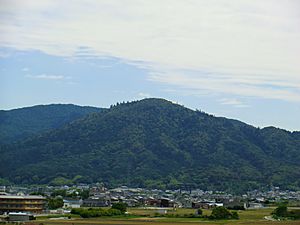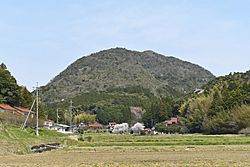Kannabi facts for kids
Kannabi (神奈備, Kamunabi / Kannabi / Kaminabi) refers to special places in Shinto, Japan's traditional religion. These are areas where people believe a divine spirit, called a Kami, lives or visits. Often, these places are natural spots like mountains, forests, or unique rocks.
A Shintai is something a god is believed to "sit" in or "dwell" within. This can be a mountain, a forest, a sacred tree, or even a special rock formation like Meoto Iwa or a waterfall like Nachi Falls. These are all considered sacred places. Sometimes, a "Kannabino" is a sacred area even without obvious forests or rocks.
Contents
What is Kannabi?
The exact meaning of the word "Kannabi" has been debated. Some think it means "god alignment," while others thought it meant a place where gods "hide." However, new discoveries have shown the "hiding" idea isn't correct.
Nature's Sacred Spaces
Kannabi shows how much animism is part of Japanese beliefs. Animism means believing that spirits live in natural things. People feel gratitude, respect, and awe for nature in these places.
Kannabi also acts like a border. It separates the world of the gods (sometimes called Shin'iki or Tokoyo) from our everyday world. Protecting these natural areas is very important. They are seen as valuable parts of the Japanese countryside, known as satoyama. Scientists have even found unique bacteria in Kannabi areas, which sometimes helps in making new medicines!
Shrines and Kannabi
Today, most Shinto shrines are called "shrines," not "Kannabi-sha." Shrine Shinto is an ancient Japanese religion that grew from early beliefs like nature worship and spirit worship.
In many modern shrines, nature itself is honored as a deity alongside other gods. You might see ropes called Shimenawa decorating sacred trees or stones. The areas around shrines, like forests, lakes, or waterfalls, are often considered sacred too. Some very old shrines don't have traditional worship halls. Instead, they treat a natural Kannabi, like a mountain or a rock, as the main deity.
Kannabi in Ancient Records
The Izumo Fudoki, an ancient record from the Izumo Province, mentions four "Kannabi" mountains. The way "Kannabi" is written in Japanese characters can be different for each one.
- In Matsue City, it's compared to Chausuyama.
- Another in Matsue City is often linked to Asahiyama.
- In Izumo City, there's Mount Taisen.
- Also in Izumo City, another Kannabi is mentioned.
See Also
- Age of the Gods
- Ko-Shintō
- Himorogi
- Iwakura
- Shintai
- Yorishiro
- Shinboku
- Sacred mountains
- Mountain worship
- Kannagi (Shinto)
- Chinju no Mori



